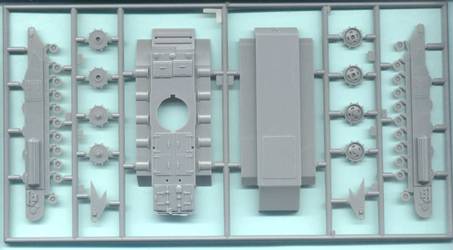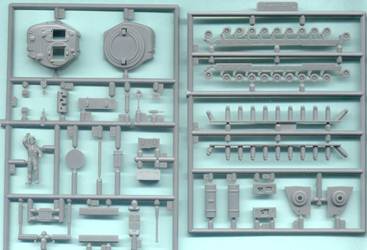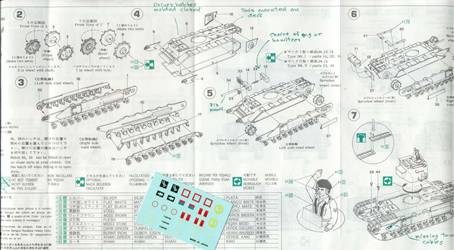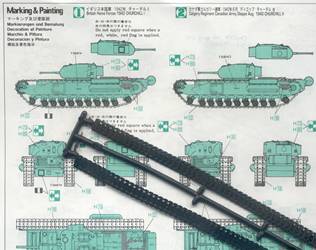This is an older
kit from the early 1990s and so far the only version of this initial
version of the Churchill Infantry tank. This AFV was designed as a
slow, heavily armored infantry support tank based on ideas reminiscent
of WW1. It is a good model kit, in my opinion, and suitable for a
display or wargaming piece. Model
Trans Modellbau company produces some cast-resin conversion sets
for this model.
This vehicle is the Mk I version of
the Churchill, characterized by a 2 pounder gun, a coaxial Besa machine
gun in a cast turret, and a bow mounted 3” howitzer in the bow.
The kit also has additional parts to build it as a Churchill
Mk II (or Churchill Ia in some references) which has a second
Besa MG in the bow instead of the howitzer. We could potentially also
convert Hasegawa's model to a Churchill Mk IICS for
Close Support (or Churchill II in some references) which had the 2
Pounder gun in the hull and the 3” howitzer in the cast turret.
ESCI/Italeri
offers a Churchill Mk III kit (though ESCI appears
to mistakenly call it a Mk IV) and Dragon has anounced a new Churchill
Mk IV kit in 1/72 in 2011.
A note on nomenclature:
The full title for the tank model in this box is the Infantry
Tank Mark IV, Churchill Mark I or the Infantry Tank
Mark IV, Churchill Mk II. This subject seems to have confused
a lot of modelers, including myself. By “Infantry Tank Mark
IV” it is meant that this is the fourth Infantry tank developed
by the British: the Matilda I was the Infantry Tank Mark I, the Matilda
II was the Infantry Tank Mark II, the Valentine was the Infantry Tank
Mark III, and the Churchill was the Infantry Tank Mark IV (the fourth
type of infantry tank they developed). So when ESCI boxed their kit
as the “Tank Mk IV Churchill” many reviewers screamed
ESCI got it wrong, “it’s a Churchill Mark III”!
Well, actually ESCI got it mostly right but they just were not complete
with the name. They should have stated it was the Infantry
Tank Mark IV Churchill Mark III: the fourth type
of British infantry tank and the third variant of the Churchill; ESCI
just left off the words Infantry at the beginning and the Mark III
at the end of the title! Hasegawa did a little better with the name
on their box but they still did not get it complete.
The box art shows what the model kit should theoretically look like
when completed and also serves as a guide for painting and markings.
In the bow we see the long 3” howitzer barrel of the Churchill
Mk I, rather than the bow machine gun of the Churchill Mk II. The
turret is a cast turret for the Mk I and Mk II Churchills and is not
the same as the cast turret for the later Churchill Mk IV. On the
turret right side and rear are two storage boxes; the long 40-mm 2
Pounder barrel protrudes from the internal gun mantlet. On the hull
side is a square crew escape hatch typical of the Churchill Mk I through
Mk VI variants; later variants had round side escape hatches. The
driver’s viewing hatch on the front plate is rectangular on
the Mark I, Mk III and Mark IV whereas the later Marks had a round
hatch.
Note that there are no track guards
(a.k.a. fenders) over the tracks which kind of makes it hard to give
a ride to supporting troops into battle. Note also that the small
roadwheels are all steel so are not to be painted tire black. On the
side is a tow cable which is not supplied in the kit. The rear engine
air intake louvers on the hull sides face down whereas upgraded Mk
I’s and later Churchill variants had a reworked design with
the air intake facing upwards. The change to intake vents facing upwards
is important to fitting wading trunks for the Dieppe and Normandy
landings.
I cannot find references for this particular
vehicle in the box art, but it best matches a photo of a vehicle exercising
in the English countryside in 1942. I have never seen a Churchill
Mk I at the Normandy landings in 1944, so I presume, based on the
landing craft tank and barrage balloons, this is a tank on landing
exercises. Many early marks of Churchill tanks were refitted and upgraded,
so by 1943 an original Mk I or Mk II is unlikely. I have seen a photo
of a Soviet Churchill Mk II on the eastern front (http://www.o5m6.de/ForeignArmour.html
). The color is a nice medium green color (British Bronze Green?)
and polished steel tracks (common when running over abrasive sand).

The kit has 48 light gray, injection molded styrene plastic parts,
not including a single crew figure and two black-colored flexible
band tracks. In this scan of Sprue A we have upper, side and lower
hull parts and the sprocket and idler wheels (Parts 2, 3, 7 &
8). The parts are sharp and cleanly molded which is typical of Hasegawa
models. The side armor parts (1 and 10) are missing some bolt detail.
The handtools on the engine deck and the spare track on the hull side
are molded on. At far left and right we see the 11 small outer all-steel
roadwheels molded onto the hull sides (parts 1 & 10).

Sprue C (at left) contains the turret parts (parts 21 & 22, etc.)
and the gun barrels (parts 34 & 35). For the 2 Pounder barrel
(part 35) I have never seen the thick ring around the muzzle. This
ring should probably be sanded down. Museum photos of the cast turret
show the turret to be very clean with no coarse cast texture or casting
seams and marks that we often see on Soviet T-34 and IS-2 cast turrets.
A little filler on the assembly seam and some sanding later is likely
all we’ll need. [This is not the same cast steel turret used
on the Churchill Mk IV or Mk VII.]
Sprue B (at above right) contains the
inner roadwheels (parts 19 & 20) and the coil spring roadwheel
suspension (parts 17 & 18). The crew figure (part 43) is good
and better than many figures included in kits, but is not up to present
standards for a good display model.

This section of Hasegawa’s assembly instructions shows the 7-Step
exploded-view instructions which are pretty clear; I noted no mistakes.
At the bottom center is the water-slide decal sheet with additional
markings not shown on the guide for the markings. On the sheet are
partial markings for a Canadian Calgary Regiment Churchill at Dieppe
in 1942; and the British First and Sixth Armored Divisions.
In step 5 of the instructions notice that there is a separate front
plate (part 14) for the 3” howitzer to produce a Churchill Mk
1, and a separate part 13 for the Churchill Mk II with the Besa machine
gun. Unfortunately, we just can’t substitute the howitzer for
the machine gun; the front plate of the tank was actually different
between the two Marks of the tank.

A painting and marking guide shows two vehicles, a Mk I at left and
a Mk II at right. The decal sheet is incomplete for a significant
number of markings for the Canadian Mk II tank at Dieppe.
The black colored soft plastic tracks
were fine for 1990 but are not up to today’s standard for detail
and accuracy. The inside track detail is generally lacking. Mud and
dirt will help here. Glue the tracks together and down to the roadwheels
with cyanoacrylate (Super) glue.
Modeling a Dieppe Raid (a.k.a.
Operation Rutter or Operation Jubilee) Churchill Mk I.
At the famous Dieppe Raid of 1942 my references state that both Churchill
Mark Is and Mark IIIs landed. Based on my references for the conversion
of the Hasegawa Churchill kit we’ll need to:
- Replace the side air intakes with
those from the ESCI Churchill Mark III or scratchbuild them, so
tall wading trunks can be attached.
- Scratchbuild the two side wading
trucks for the air intake and the rear stack for the air exhaust.
- Scratchbuild the two vertical deep
wading engine exhaust pipes.
- Find complete suitable 1/72 or
1/76 scale markings for the 1st Canadian Army Tank Brigade, 14th
Armoured Calgary Regiment of 1942. These tanks had names beginning
with the Squadron designation, i.e. Squadron B tanks had names Bob,
Bolster and Bert, etc. The tanks also have outlined black boxes
with white numbers on the turret sides.
- Leave off the turret’s side
storage box (part 32) and the rear fuel drum (parts 11 & 12).
- Add a short run of track guard over
the tracks at the rear next to where the side wading stacks are
located.
- For a good idea of a representation
of a Dieppe Raid Churchill see the 1/76-scale Milicast
model.
References
- THE CHURCHILL TANK, by Brent Perrett,
Osprey Publishing Ltd. (1980). ISBN 0 85045 340 2
- BRITISH AND AMERICAN TANKS OF WORLD
WAR TWO 1933-1945, by Peter Chamberlain and Chris Ellis, Cassell
& Co., (1969). ISBN 0-304-35529-1
- http://www.armourinfocus.co.uk/
Chris Shillito’s excellent website on Allied armor.
- http://beute.narod.ru/Beutepanzer/uk/A22_churchill/a22churchill-1.htm
- http://www.o5m6.de/ForeignArmour.html
|